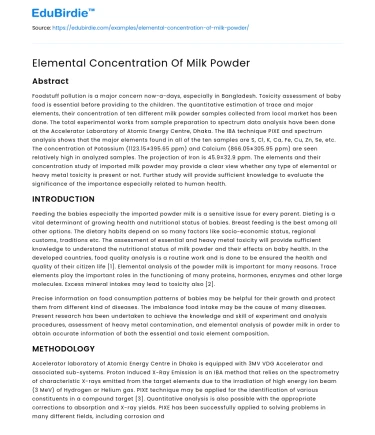Abstract
Foodstuff pollution is a major concern now-a-days, especially in Bangladesh. Toxicity assessment of baby food is essential before providing to the children. The quantitative estimation of trace and major elements, their concentration of ten different milk powder samples collected from local market has been done. The total experimental works from sample preparation to spectrum data analysis have been done at the Accelerator Laboratory of Atomic Energy Centre, Dhaka. The IBA technique PIXE and spectrum analysis shows that the major elements found in all of the ten samples are S, Cl, K, Ca, Fe, Cu, Zn, Se, etc. The concentration of Potassium (1123.15±395.65 ppm) and Calcium (866.05±305.95 ppm) are seen relatively high in analyzed samples. The projection of Iron is 45.9±32.9 ppm. The elements and their concentration study of imported milk powder may provide a clear view whether any type of elemental or heavy metal toxicity is present or not. Further study will provide sufficient knowledge to evaluate the significance of the importance especially related to human health.
INTRODUCTION
Feeding the babies especially the imported powder milk is a sensitive issue for every parent. Dieting is a vital determinant of growing health and nutritional status of babies. Breast feeding is the best among all other options. The dietary habits depend on so many factors like socio-economic status, regional customs, traditions etc. The assessment of essential and heavy metal toxicity will provide sufficient knowledge to understand the nutritional status of milk powder and their effects on baby health. In the developed countries, food quality analysis is a routine work and is done to be ensured the health and quality of their citizen life [1]. Elemental analysis of the powder milk is important for many reasons. Trace elements play the important roles in the functioning of many proteins, hormones, enzymes and other large molecules. Excess mineral intakes may lead to toxicity also [2].
Save your time!
We can take care of your essay
- Proper editing and formatting
- Free revision, title page, and bibliography
- Flexible prices and money-back guarantee
Precise information on food consumption patterns of babies may be helpful for their growth and protect them from different kind of diseases. The imbalance food intake may be the cause of many diseases. Present research has been undertaken to achieve the knowledge and skill of experiment and analysis procedures, assessment of heavy metal contamination, and elemental analysis of powder milk in order to obtain accurate information of both the essential and toxic element composition.
METHODOLOGY
Accelerator laboratory of Atomic Energy Centre in Dhaka is equipped with 3MV VDG Accelerator and associated sub-systems. Proton Induced X-Ray Emission is an IBA method that relies on the spectrometry of characteristic X-rays emitted from the target elements due to the irradiation of high energy ion beam (3 MeV) of Hydrogen or Helium gas. PIXE technique may be applied for the identification of various constituents in a compound target [3]. Quantitative analysis is also possible with the appropriate corrections to absorption and X-ray yields. PIXE has been successfully applied to solving problems in many different fields, including corrosion and oxidation, semiconductors, metallurgy, thin films, geosciences, air pollution and atmospheric science, biology, medicine, art, archaeology, water analysis, and forensic science. PIXE is well adapted to measure major, minor and trace element in different sample matrices [4-5]. The present research works has been utilized PIXE for irradiation and analysis of a number of powder milk samples.
When charged particles with sufficient energy hit a sample, a vacancy in the inner shells of an atom may be created. The probability of creating a vacancy is higher when velocity of the incoming ions matches the velocity of the inner shell electrons. This probability (cross-section) for ejecting inner shell electrons is quite high (of the order of barns) for MeV ions. Such a vacancy can be filled in a number of ways and one of the processes may emit X-rays with energy characteristic of that particular atomic number. This characteristic X-rays are detected using solid state semiconductor detector [6].
SAMPLING AND PREPARATION
Ten different powder milk samples were collected from local market for this research works. According to the labeling of the packet, three of them were for the babies aged born up to 6 months, three were for aged 6+ months to 2 years which were collected from departmental store and rest of the four powder milk samples were collected from local shops. All of the powder milk samples were dried using electric oven at the temperature of 450C continuously during 7 days to make completely moisture free. The samples were ground in an Agate Mortal Pester for fine powder [7-8]. To avoid cross contamination, the Pester was cleaned by acetone (CH3-CO-CH3) for every sample. 0.25gm of powder milk was taken and pelletized to make pellet (7mm dia. and 1mm thick). Finally, the pellets were preserved in vacuum desiccator to protect them from any type of contamination. Next the pellets were set in the ion beam scattering chamber on sample-wheeler for irradiation by proton beam of 2.4 MeV [9].
CONCLUSION
PIXE technique is employed to the study of elemental constituents of some milk powders generally people used those every day in Bangladesh. Sufficiently high concentrations of Si, Cl, K, and Ca were found in the samples. Further, good correlations between the concentrations of K and Cl in the milk samples are also observed. But Fe content in the samples analyzed was not up to the expectation level. So far, no toxic elements such as Cd, Pb and Hg etc. are not detected. The maximum concentration was found for Ca and the minimum was found for Se. The product was found to be wholesome with regards to the content of major and trace elements.






 Stuck on your essay?
Stuck on your essay?

